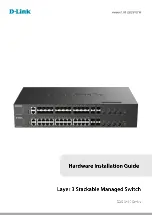
1-4
Parameters
instance-id
: ID of the MSTI ranging from 0 to 16. The value of 0 refers to the common and internal
spanning tree (CIST).
interface-list
: Ethernet port list. You can specify multiple Ethernet ports by providing this argument in the
form of
interface-list =
{
interface-type interface-number
[
to
interface-type interface-number
] } &<1-10>,
where &<1-10> means that you can provide up to 10 port indexes/port index ranges for this argument.
slot slot-number
: Specifies a slot whose STP-related information is to be displayed.
brief
: Displays only port state and protection measures taken on the port.
Description
Use the
display stp
command to display the state and statistical information about one or all spanning
trees.
The state and statistical information about MSTP can be used to analyze and maintain the topology of a
network. It can also be helpful when trying to make MSTP operate properly.
z
If neither MSTI nor port list is specified, the command displays spanning tree information about all
MSTIs on all ports in the order of port number.
z
If only one MSTI is specified, the command displays information about the specified MSTI on all
ports in the order of the port number.
z
If only a port list is specified, the command displays information about all MSTIs on these ports in
the order of the port numbers.
z
If both an MSTI ID list and a port list are specified, the command displays spanning tree information
about the specified MSTIs and the specified ports in the order of MSTI ID.
MSTP state information includes:
1) Global CIST parameters: Protocol operating mode, switch priority in the CIST instance, MAC
address, hello time, max age, forward delay, max hops, the common root of the CIST, the external
path cost for the switch to reach the CIST common root, region root, the internal path cost for the
switch to reach the region root, CIST root port of the switch, the state of the BPDU guard function
(enabled or disabled), the state of the digest snooping feature (enabled or disabled), and the state
of the TC-BPDU attack guard function (enabled or disabled).
2) CIST port parameters: Port protocol, port role, port priority, path cost, designated bridge,
designated port, edge port/non-edge port, whether or not the link on a port is a point-to-point link,
format of the MST BPDUs that the port can send, the maximum transmitting speed, type of the
enabled guard function, state of the digest snooping feature (enabled or disabled), VLAN mappings,
hello time, max age, forward delay, Message-age time, and remaining hops.
3) Global MSTI parameters: MSTI instance ID, bridge priority of the instance, region root, internal
path cost, MSTI root port, master bridge, and external path cost.
4) MSTI port parameters: Port state, role, priority, path cost, designated bridge, designated port,
remaining hops, and the number of VLANs mapped to the current MSTI.
The statistical information includes: the numbers of the TCN BPDUs, the configuration BPDUs, the RST
BPDUs, and the MST BPDUs transmitted/received by each port.
Related commands:
reset stp
.
Examples
# Display the brief state information of MSTI 0 on Ethernet 1/0/1 through Ethernet 1/0/4.
Summary of Contents for 5500-EI PWR
Page 43: ...2 6...
Page 76: ...1 17...
Page 228: ...ii stp transmit limit 1 44 vlan mapping modulo 1 45 vlan vpn tunnel 1 46...
Page 477: ...5 24 Sysname vlan 2 Sysname vlan2 service type multicast...
Page 503: ...2 3 System View return to User View with Ctrl Z Sysname dot1x url http 192 168 19 23...
Page 519: ...iii...
Page 597: ...2 2 security policy server 192 168 0 1 user name format without domain...
Page 648: ...1 9 Examples Clear static ARP entries Sysname reset arp static...
Page 663: ...4 3 Sysname resilient arp interface vlan interface 2...
Page 767: ...1 28 From 12 00 Jan 1 2008 to 12 00 Jun 1 2008...
Page 1111: ...ii xmodem get 3 18...
Page 1314: ...A 44 Z...
















































